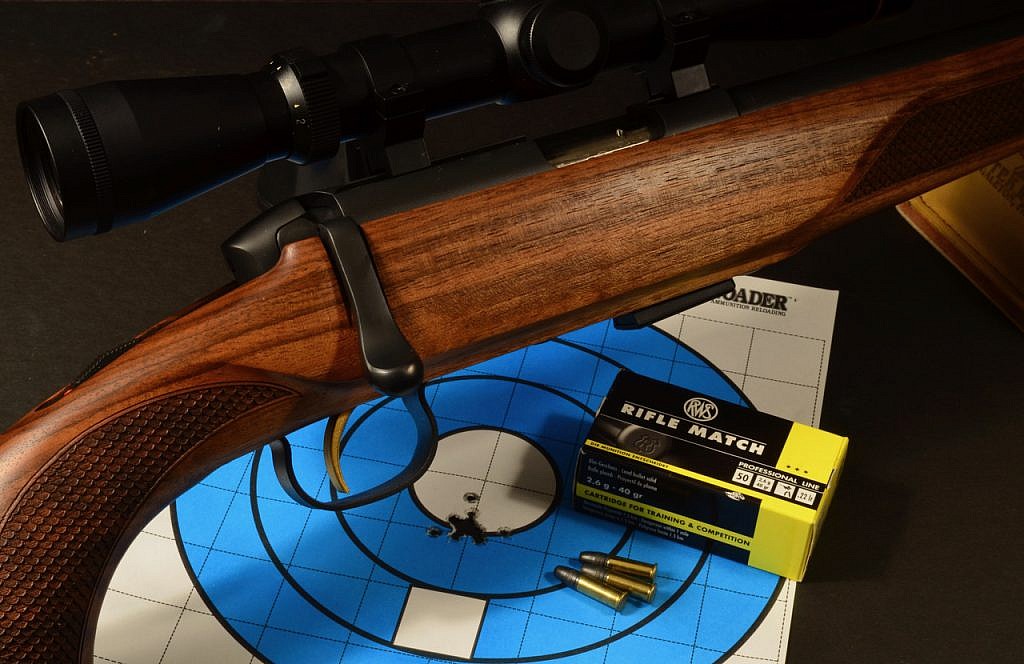
by Terry Wieland
Like most shooters of my acquaintance, my hunting and shooting career began with the .22 Long Rifle, and may well end with it.
For the young, the merits of the .22 are that rifles and ammunition are inexpensive, and adults widely perceive it as not overly dangerous; for those of us who are getting on, its merits are that it’s simple, cheap, low recoil, and you shoot it at targets that are generally within easy walking distance, to say nothing of tin cans, broken clays, and fallen leaves on a mud bank.
And, if you’re a compulsive handloader, you don’t find yourself on your hands and knees searching in the gravel for brass. (When you reach a certain depth of handloading lunacy, either you recover your brass religiously or learn to live with the guilt. The .22 eliminates both.)

One thing I remember clearly about shooting a .22 when I was 14 was that the boxes of C-I-L “Canuck” ammunition carried a clear warning that the bullets were dangerous out to a mile. A little research revealed that, for a 40-grain bullet to carry that far, it needed to be shot into the air at about a 40-degree angle, and having a tail wind didn’t hurt. Therefore, if shooting at a crow perched high in a tree, you should have a good idea what lies a mile beyond. If it’s a subdivision, best leave the crow to its own devices.
This is all pretty simple and sensible, and ever since, I’ve made sure of my backstops, whether I’m shooting a .22 or a .505 Gibbs. Lessons learned in childhood.
Recently, suffering from a variety of shoulder problems, I’ve taken up .22s once more, this time rather more seriously. It was sparked by re-reading C.S. Landis’s classic .22 Caliber Rifle Shooting, originally published by Samworth in 1932 and reprinted several times since. If you don’t have it, I recommend it highly, if only for a glimpse at the travails of .22 enthusiasts a century ago.
Judge Charles Landis was a highly accomplished .22 shooter, winning matches at the small-bore championships at Sea Girt, among others. He published his first book in 1922, his last in 1951. He devotes considerable space to the ballistic performance of the ammunition then available, and to the records that were set on target ranges. The .22 LR available in 1930 was, surprisingly, not wildly different than what we get today: 40-grain bullet, 1,100 feet per second (fps).


Top shooters, armed with Winchester 52s, Stevens target rifles, and Martinis were putting ten shots into four inches at 200 yards with boring regularity and, at 300 yards, the very best were putting ten shots into a ten-inch bull. Landis even mentioned one hotshot who was doing admirably at 500 yards. Five hundred! With a .22 Long Rifle!
At various times, I’ve pondered trying out different types of ammunition at those ranges, using some good rifles, and this seemed as good a time as any. So one day I packed up my Stevens Ideal Model 49, a Steyr Zephyr II, and a Blaser R8 (the latter two with scopes) and set out to see what I could accomplish with SK Long Range Match ammunition.
What I should have done, but did not, was compile a trajectory chart. Instead, I figured to set up targets at 100, 200, and 300 yards, and inch my way out, adjusting the sights upward as I went. With big sheets of blank white paper behind to record errant bullets, what could go wrong?
Well, what went wrong was that I did not realize—and after 60 years of shooting .22s, surely I should have—what I did not realize was that when you extend your range from 100 to 200 yards with a .22, you are talking about drop measured in feet, not inches, and when you get to 300 yards, it could be measured in yards. That little 40-grain bullet, once it passes a hundred yards, starts to drop like a rock.
I later figured out that, to sight in close in order to hit something far out—the usual approach—I would have had to have the rifle shooting more than two feet high at 50 yards in order to get on the paper at 300. The mid-range trajectory is around 51 inches (more than four feet) so it’s easy to be off the board completely, never mind missing the bull.
If you look at the trajectory on a graph, it resembles the St. Louis arch.
Out of curiosity, I tried to figure the requirements for shooting at 500 yards. The mid-range trajectory is more than 15 feet, and you would have to be shooting nine feet high at 100 yards to get on paper. These requirements are, first of all, beyond the capability of the average target board, no matter how big your sheet of clean white paper, and second, very likely beyond the adjustment capability of many scopes.
Having figured this all out, I’m going back out to the range to give it a second try, but with my expectations drastically reduced, and my respect for C.S. Landis and his pals drastically increased.
Gray’s shooting editor, Terry Wieland, now realizes—a little late in the game—why he could never hit anything beyond 50 yards with his single-shot Cooey .22.
